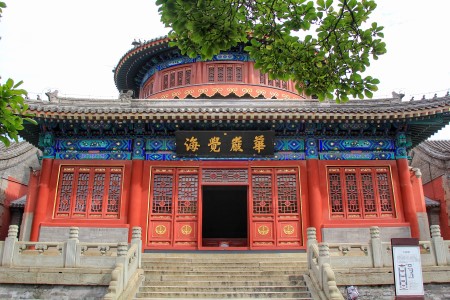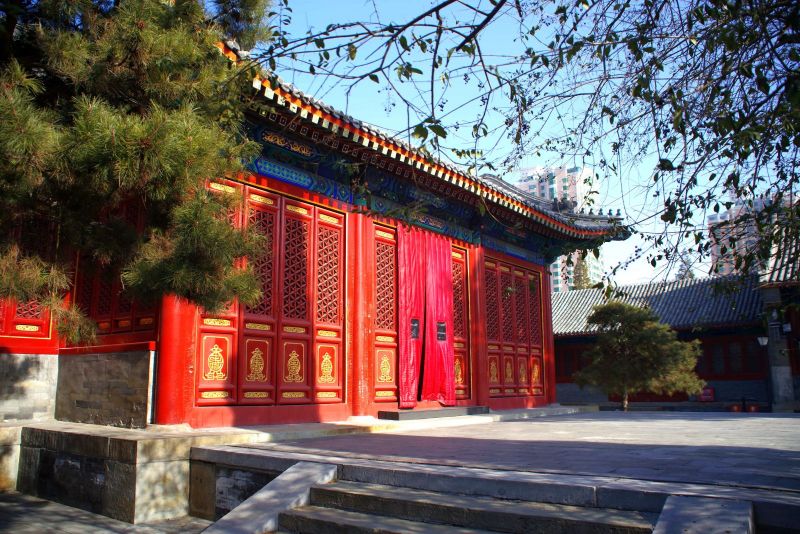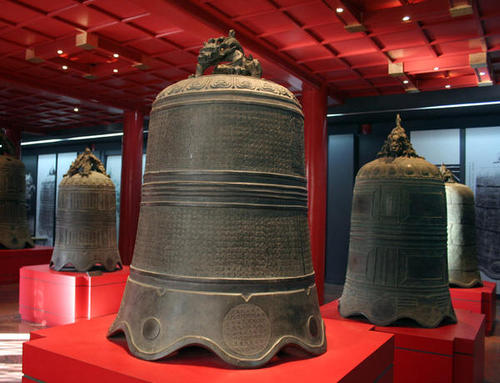Chinese Name: 大钟寺 Pronunciation: dà zhōng sì
Building Time: 1733
Best Visiting Season: All seasons
Occupied Area: About 38,000 square meters
Recommended Time for Visit: 1-2 Hours
Address: No. 31A West Road, North 3rd Ring Road, Haidian District, Beijing
Building Function: Emperors of the Qing Dynasty (1644-1912) prayed for rain for good harvests.
| Tourists | Ticket Price |
|
Adults & Children
(taller than 1.4 meters)
|
30 yuan |
|
Seniors Aged 65-69
(with valid Chinese Seniors Card or ID card)
|
15 yuan |
|
College Students
(with valid Chinese Students Card)
|
15 yuan |
1. Free for first 200 visitors on each Wednesday;
2. Disabled people with valid certificate;
| Contents | Time |
| Big Bell Temple | 1st January – 31st December |
| Opening Hours | 9:00-16:30 |
| Ticket Office Opening Hours | 9:00-16:00 |

The Big Bell Temple, originally a royal Buddhist temple, was established as an ancient bell museum in 1985. It is the only museum of ancient bells in China with about 400 groups of ancient bells from China and foreign countries. From south to north, the Big Bell Temple is composed of gate, Drum and Bell Towers, Hall of Heavenly King, Hall of Avalokitesvara, Depository of Buddhist Sutras, Great Bell Tower and its two subordinate towers on each side, six side wings on either side of the main temple, and Nine-Pavilion Bell Garden on the east side of the main temple.
One site that should not be missed is the Great Bell Tower where the world-famous Yongle Great Bell is hanging in the center. A horizontally inscribed board hanging over the front door is with inscription “huá yán jué hǎi” (华严觉海, the name of Buddhist scriptures) written by Emperor Qianlong (reign from 1736 to 1795) of the Qing Dynasty. The tower has two floors; the roof of the upper floor is round, and the lower floor is square. This kind of structure implies the long-standing concept of “Round Sky and Square Earth” (天圆地方) in China.

In China, the bell is a symbol of rites and music system in the Spring and Autumn Period (770BC to 476BC) and the Warring States Period (475BC to 221BC). People according to their status shall use different classes of bells and kinds of music. Entering the Qin and Han Dynasties (221BC to 220AD), this rites and music system faded out of history. However, the function of the bell was preserved, and until now, it is still a cultural sign.
So, the Big Bell Temple is provided with a bell for tourists to knock - you may knock three times, respectively praying peace, happiness, and auspiciousness. Whenever it is on the first day of the Chinese New Year or ordinary days, knocking on the bell is a blessing, and if you have the chance of visiting during the Chinese New Year holiday, the knock should be expressing your best wishes.
In the first month of the Chinese lunar calendar in 1733, Emperor Yongzheng (reign from 1723 to 1735) in the Qing Dynasty, ordered to build the Juesheng Temple as a royal temple and was finished in the winter of 1734.

In 1743, Emperor Qianlong decided to move the Yongle Great Bell from Wanshou Temple (famous as the royal Buddhist temple and palace, and the imperial garden of the Qing Dynasty) to the Juesheng Temple. Since then, the Juesheng Temple is also called the Big Bell Temple.
From 1743 to the late Qing Dynasty, the royal household came here to pray for rain and gods.
On March 11th, 1980, the Cultural Relic Administrative Office of the Great Bell Temple was established by the Beijing Municipal Government.
In November 1984, the Big Bell Temple Museum was founded.
In December 1996, the State Council designated the Big Bell Temple as one of the state-level protected cultural relic sites.

The Yongle Great Bell is famous as "King of the Bell" and is considered one of the world-famous bells in Encyclopedia Britannica. It was cast with bronze during the Yongle Period (1403-1424) of the Ming Dynasty (1368-1644) and has worshiped a long history of more than 500 years. The Yongle Great Bell is about 6.75 meters (22.14 feet) high. The diameter of the Bell end is about 3.3 (10.8 feet) meters, and it is about 46.5 tons in weight.
The Yongle Great Bell features carved Buddhist scriptures in Chinese and Sanskrit on its inside and outside, with a total number of about 230,000 characters. The Bell features in its shape, long history, carved scriptures, long-lasted bell ring, scientific structure, and excellent casting process. Its long-lasting sound may be heard for more than two minutes.

The Yongle Great Bell, the largest bronze bell in China, had been relocated several times. It was first placed in Hanjingchang, an official agency to print Buddhist scripture in China, very close to the Forbidden City. After the death of Emperor Yongle, it had been forgotten for over 150 years. When the Wanshou Temple was built in the west of Beijing in 1577, the bell was mounted there. It has the chance to be voiced again.
A rumor, however, gradually spread in Beijing - the rings in the west of Beijing would bring disaster to Beijing. As Emperor Xizong of the Ming Dynasty (reign from 1620 to 1627) heard of it, he ordered to unload the Bell.
When it comes to the Qing Dynasty, as the Big Bell Temple was the Juesheng Temple in the north of Beijing, a minister suggested that with the Five-Elements Theory, metal and earth are mutually promoting to be a good omen. Because the Juesheng Temple was the symbol of the earth for its location in the north of Beijing, and the Yongle Great Bell was the symbol of the metal, the Bell was moved into the Juesheng Temple in 1607 and has been kept there ever since.
Enter from the Temple Gate →Drum and Bell Towers→ Hall of Heavenly King →Hall of Mahavira → Hall of Avalokitesvara → Depository of Buddhist Sutras → The Great Bell Tower → Nine-Pavilion Bell Garden
Take Bus BRT300, 315, 361, 425, 584, 606, 658, 695, 87, 88, 921, 94, Shuttle 168, 30 night line, or Double-decker 8, and get off at DAZHONGSI Station.
Take Metro Line 13 and get off at DAZHONGSI Station, exit A, and walk about 600 meters to the west.
Chinese: 请带我去大钟寺。English: Please take me to the Big Bell Temple.
If you go to the Big Bell Temple from the center of Beijing (Grand Hyatt Beijing), it takes about 35 minutes (about 55 yuan).
If you go to the Big Bell Temple from Beijing Capital International Airport, it takes about 50 minutes (about 110 yuan).
If you go to the Big Bell Temple from Beijing Daxing International Airport, it takes about an hour (about 220 yuan).
If you go to the Big Bell Temple from Beijing West Railway Station, it takes about 20 minutes (about 45 yuan).
